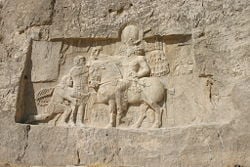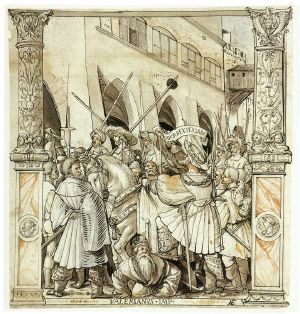Shapur I
| Shapur I | ||
|---|---|---|
| "King of kings of Iran and Aniran"[1] (Middle Persian: šāhān šāh ērān ud anērān) | ||
| 250px | ||
| Reign | 241 - 272 C.E. | |
| Coronation | 12 April 241 | |
| Born | c. 215 C.E. | |
| possibly Firuzabad | ||
| Died | 272 | |
| Bishapur | ||
| Buried | Unknown | |
| Predecessor | Ardeshir I | |
| Successor | Bahram I | |
| Royal House | Sasan | |
| Father | Ardeshir I | |
| Mother | Lady Myrōd | |
Shapur I was the second Sassanid King of the Second Persian Empire. The dates of his reign are commonly given as 241 - 272, but it is likely that he also reigned as co-regent (together with his father) prior to his father's death in 241.
Early years
Shapur was the son of Ardeshir I (r. 226–241), the founder of the Sassanid dynasty and whom Shapur succeeded. His mother was Lady Myrōd,[2] who—according to legend[3]—was an Arsacid princess.
Shapur accompanied his father's campaigns against the Parthians, who - at the time - still controlled much of the Iranian plateau through a system of vassal states that the Persian kingdom had itself previously been a part of. Before an assembly of magnates, Ardeshir "judged him the gentlest, wisest, bravest and ablest of all his children"[2] and nominated him as his successor. Shapur also appears as heir apparent in Ardeshir's investiture inscriptions at Naqsh-e Rajab and Firuzabad. The Cologne Mani-Codex indicates that, by 240, Ardeshir and Shapur were already reigning together.[2] In a letter from Gordian III to his senate, dated to 242, the "Persian Kings" are referred to in the plural. Synarchy is also evident in the coins of this period that portray Ardashir facing his youthful son, and which are accompanied by a legend that indicates that Shapur was already referred to as king.
The date of Shapur's coronation remains debated, but 241 is frequently noted.[2] That same year also marks the death of Ardeshir, and earlier in the year, his and Shapur's seizure and subsequent destruction of Hatra, about 100 km southwest of Nineveh and Mosul in present-day Iraq. According to legend, al-Nadirah, the daughter of the king of Hatra, betrayed her city to the Sassanids, who then killed the king and had the city razed. (Legends also have Shapur either marrying al-Nadirah, or having her killed, or both).[4]
War against the Roman Empire

Ardashir I had, towards the end of his reign, renewed the war against the Roman Empire. Shapur I conquered the Mesopotamian fortresses Nisibis and Carrhae and advanced into Syria. Timesitheus, father-in-law of the young emperor, Gordian III, drove him back and defeated him at the Battle of Resaena in 243, regaining Nisibis and Carrhae. Timesitheus died shortly afterward, and Philip the Arab (244–249) murdered Gordian III after his defeat at the Battle of Misiche. Philip then concluded an ignominious peace with the Persians in 244. With the Roman Empire debilitated by Germanic invasions and the continuous elevation of new emperors after the death of Trajan Decius (251), Shapur I resumed his attacks.
Shapur conquered Armenia, invaded Syria, and plundered Antioch. Eventually, the Emperor Valerian (253–260) marched against him and by 257, Valerian had recovered Antioch and returned the province of Syria to Roman control. In 259, Valerian moved to Edessa, but an outbreak of plague killed many and weakened the Roman troops defending the city which was then beseiged by the Persians. In 260, Valerian arranged a meeting with Shapur to negotiate a peace settlement but was betrayed by Shapur who seized him and held him prisoner for the remainder of his life.[5] Shapur advanced into Asia Minor, but was driven back by defeats at the hands of Balista, who captured the royal harem. Septimius Odenathus, prince of Palmyra, rose in his rear, defeated the Persian army and regained all the territories Shapur had occupied. Shapur was unable to resume the offensive and lost Armenia again.

Shapur personally considered one of the great achievements of his reign to be the defeat of the Roman Emperor Valerian. This is presented in a mural at Naqsh-e Rustam, where Shapur is represented on horseback wearing royal armour and crown. Before him kneels Philip the Arab, in Roman dress, asking for grace. In his right hand the king grasps the uplifted arms of what may be Valerian; one of his hands is hidden in his sleeve as the sign of submission. The same scene is repeated in other rock-face inscriptions. Shapur is said to have publicly shamed Valerian by using the Roman Emperor as a footstool when mounting his horse.[6] Other sources contradict and note that in other stone carvings, Valerian is respected and never on his knees. This is supported by reports that Valerian and some of his army lived in relatively good conditions in the city of Bishapur and that Shapur enrolled the assistance of Roman engineers in his engineering and development plans.
Builder of cities
Shapur I left other reliefs and rock inscriptions. A relief at Naqsh-e Rajab near Istakhr, is accompanied by a Greek translation. Here Shapur I calls himself "the Mazdayasnian (worshipper of Ahuramazda), the divine Sapores, King of Kings of the Aryans, Iranians, and non-Aryans, of divine descent, son of the Mazdayasnian, the divine Artaxerxes, King of Kings of the Aryans, grandson of the divine king Papak." Another long inscription at Istakhr mentions the King's exploits in archery in the presence of his nobles. From his titles we learn that Shapur I claimed the sovereignty over the whole earth, although in reality his domain extended little farther than that of Ardashir I. Shapur I built the great town Gundishapur near the old Achaemenid capital Susa, and increased the fertility of the district by a dam and irrigation system - built by the Roman prisoners - that redirected part of the Karun River. The barrier is still called Band-e Kaisar, "the mole of the Caesar." He is also responsible for building the city of Bishapur, also built by Roman soldiers captured after the defeat of Valerian in 260.
Interactions with minorities
Shapur is mentioned many times in the Talmud, as King Shabur. He had good relations with the Jewish community and was a friend of Shmuel, one of the most famous of the Babylonian Amoraim.
Under Shapur's reign, the prophet Mani, the founder of Manichaeism, began his preaching in Western Iran, and the King himself seems to have favoured his ideas. The Shapurgan, Mani's only treatise in the Middle Persian language, is dedicated to Shapur.
| Sassanid dynasty | ||
|---|---|---|
| Preceded by: Ardashir I |
"King of kings of Iran and Aniran" 241 –272 |
Succeeded by: Hormizd I |
Bibliography
- ↑ MacKenzie, David Niel (1998), "Ērān, Ērānšahr", Encyclopedia Iranica, vol. 8, Costa Mesa: Mazda
- ↑ 2.0 2.1 2.2 2.3 Shahbazi, Shapur. (2003). "Shapur I". Encyclopedia Iranica. Costa Mesa: Mazda.
- ↑ Herzfeld, E. E. (1988). Iran in the Ancient East. ISBN 0-87817-308-0. p. 287.
- ↑ 2008, "Hatra", Encyclopædia Britannica. Retrieved 8 December 2007
- ↑ Valerian [1]
- ↑ Weigel, Richard D. (1998). Valerian and Gallienus. De Imperatoribus Romanis.
- This article incorporates text from the Encyclopædia Britannica Eleventh Edition, a publication now in the public domain.
ar:سابور بن أردشير ca:Sapor I cs:Šápúr I. de:Schapur I. es:Sapor I fa:شاپور یکم fr:Shapur Ier gl:Shapur I ko:샤푸르 1세 hy:Շապուհ I hr:Šapur I. it:Sapore I he:שבור הראשון la:Sapor I hu:I. Sápúr nl:Shapur I ja:シャープール1世 no:Sjahpur I av Persia pl:Szapur I pt:Shapur I da Pérsia ru:Шапур I sk:Šápúr I. sl:Šapur I. sr:Шапур I sh:Šapur I fi:Sapor I sv:Shahpour I th:พระเจ้าซาปูร์ที่ 1 vi:Shapur I tr:I. Şapur zh:沙普尔一世
Credits
New World Encyclopedia writers and editors rewrote and completed the Wikipedia article in accordance with New World Encyclopedia standards. This article abides by terms of the Creative Commons CC-by-sa 3.0 License (CC-by-sa), which may be used and disseminated with proper attribution. Credit is due under the terms of this license that can reference both the New World Encyclopedia contributors and the selfless volunteer contributors of the Wikimedia Foundation. To cite this article click here for a list of acceptable citing formats.The history of earlier contributions by wikipedians is accessible to researchers here:
The history of this article since it was imported to New World Encyclopedia:
Note: Some restrictions may apply to use of individual images which are separately licensed.